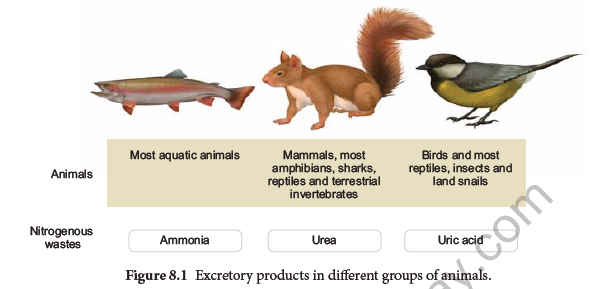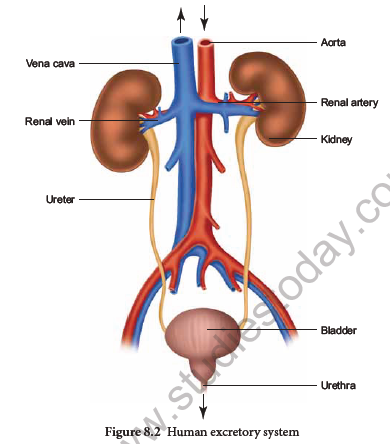Chapter Outline
8.1 Modes of Excretion
8.2 Human excretory system
8.3 Mechanism of urine formation in human
8.4 Regulation of kidney function
8.5 Micturition
8.6 Role of other organs in excretion
8.7 Disorders related to the excretory system
8.8 Haemodialysis
Learning Objectives:
• Understands different modes of excretion in animals.
• Learns the structure of the human excretory system.
• Understands the structure of a nephron, mechanism of urine formation - glomerular filtration reabsorption and secretion from the renal tubules.
• Visualizes the blood supply to the kidney including the nephrons
• Learns about the possible kidney related diseases.
Earliest animal life forms arose around 700 million years ago. They were marine organisms like the modern sponges. Each cell of a modern sponge is surrounded by sea water, but it maintains an intracellular ionic composition different from that of the sea water. Evolution led to changes in the organisation of the tissue layers followed by formation of specialized external tissue layers. This provided a barrier between the external environment and internal fluid resulting in the formation of extracellular fluid. Major changes in osmoregulation and ionic regulation occurred during the evolution of chordates. The ability to control extracellular fluid composition was essential for the diversification of animals to inhabit brackish water, fresh water and land. Animals that invaded land had the risk of desiccation and were unable to excrete metabolic waste directly into the water; hence there was a need for an alternate pathway to dispose the nitrogenous wastes.
Most animals rely on kidneys to control ionic and water balance. Some animals depend on external tissues such as the gills, skin and digestive mucosa to collectively regulate three homeostatic processes namely, osmotic regulation, ionic regulation and nitrogen excretion.Osmotic regulation is the control of tissue osmotic pressure which acts as a driving force for movement of water across biological membranes. Ionic regulation is the control of the ionic composition of body fluids. The process by which the body gets rid of the nitrogenous waste products of protein metabolism is called excretion. Nitrogen excretion is the pathway by which animals excrete ammonia, the toxic nitrogenous end product of protein catabolism. The removal of ammonia or other metabolic alternatives such as urea and uric acid is linked to ionic and osmotic homeostasis.
Fresh water vertebrates maintain higher salt concentrations in their body fluids; marine vertebrates maintain lower salt concentrations in their body fluids and terrestrial animals have more water in their body than the surrounding hence tend to lose water by evaporation. Osmoconformers are able to change their internal osmotic concentration with change in external environment as in marine molluscs and sharks. Osmoregulators maintain their internal osmotic concentration irrespective of their external osmotic environment (example: Otters).Depending on the ability to tolerate changes in the external environment, animals are classified as stenohaline and euryhaline. The stenohaline animals can tolerate only narrow fluctuations in the salt concentration (example: Gold fish), whereas the euryhaline animals are able to tolerate wide fluctuations in the salt concentrations eg., Artemia, Tilapia and salmons.
The major nitrogenous waste products are ammonia, urea and uric acid. Other waste products of protein metabolism are trimethyl amine oxide (TMO) in marine teleosts, guanine in spiders, hippuric acid, allantonin, allantoic acid, ornithuric acid, creatinine, creatine, purines, pyramidines and pterines.
8.1 Modes of Excretion
Excretory system helps in collecting nitrogenous waste and expelling it into the external environment. Animals have evolved different strategies to get rid of these nitrogenous wastes. Ammonia produced during amino acid breakdown is toxic hence must be excreted either as ammonia, urea or uric acid. The type of nitrogenous end product an animal excretes depends upon the habitat of the animal. Ammonia requires large amount of water for its elimination, whereas uric acid, being the least toxic can be removed with the minimum loss of water, and urea can be stored in the body for considerable periods of time, as it is less toxic and less soluble in water than ammonia.
Animals that excrete most of its nitrogen in the form of ammonia are called ammonoteles. Many fishes, aquatic amphibians and aquatic insects are ammonotelic. In bony fishes, ammonia diffuses out across the body surface or through gill surface as ammonium ions. Reptiles, birds, land snails and insects excrete uric acid crystals, with a minimum loss of water and are called uricoteles.In terrestrial animals, less toxic urea and

uric acid are produced to conserve water.Mammals and terrestrial amphibians mainly excrete urea and are called ureoteles.Earthworms while in soil are ureoteles and when in water are ammonoteles. Figure 8.1 shows the excretory products in different groups of animals.
The animal kingdom presents a wide variety of excretory structures. Most invertebrates have a simple tubular structure in the form of primitive kidneys called protonephridia and metanephridia.Vertebrates have complex tubular organs called kidneys. Protonephridia are excretory structures with specialized cells in the form of flame cells (cilia) in Platyhelminthes (example tapeworm) and Solenocytes (flagella) in Amphioxus. Nematodes have rennette cells, Metanephridia are the tubular excretory structures in annelids and molluscs. Malpighian tubules are the excretory structures in most insects.Antennal glands or green glands perform excretory function in crustaceans like prawns. Vertebrate kidney differs among taxa in relation to the environmental conditions
Nephron is the structural and functional unit of kidneys. Reptiles have reduced glomerulus or lack glomerulus and Henle’s loop and hence produce very little hypotonic urine, whereas mammalian kidneys produce concentrated (hyperosmotic) urine due to the presence of long Henle’s loop. The Loop of Henle of the nephron has evolved to form hypertonic urine. Aglomerular kidneys of marine fishes produce little urine that is isoosmotic to the body fluid. Amphibians and fresh water fish lack Henle’s loop hence produce dilute urine (hypoosmotic).
The average bladder holds between 300ml and 600ml of urine. If the urinary system is healthy, urine may stay in the bladder for up to about 5 hours before excretion, depending on the amount of liquid consumed. Nerves send signals to the brain when the bladder needs to be emptied, with this indication one will feel the urge to empty the bladder. The muscle in the bladder wall is called the ‘detrusor’ muscle. One may suffer from stress if the muscles supporting the bladder are weakened. Pelvic floor exercise helps to strengthen these muscles.

8.2 Human excretory system
8.2.1 Structure of kidney
Excretory system in human consists of a pair of kidneys, a pair of ureters, urinary bladder and urethra (Figure. 8.2). Kidneys are reddish brown, bean shaped structures that lie in the superior lumbar region between the levels of the last thoracic and third lumber vertebra close to the dorsal inner wall of the abdominal cavity. The right kidney is placed slightly lower than the left kidney. Each kidney weighs an average of 120-170 grams. The outer layer of the kidney is covered by three layers of supportive tissues namely, renal fascia,perirenal fat capsule and fibrous capsule.
The longitudinal section of kidney (Figure.8.3) shows, an outer cortex, inner medulla and pelvis. The medulla is divided into a few conical tissue masses called medullary pyramids or renal pyramids. The part of cortex that extends in between the medullary pyramids is the renal columns of Bertini.The centre of the inner concave surface of the kidney has a notch called the renal hilum, through which ureter, blood vessels and nerves innervate. Inner to the hilum is a broad funnel shaped space called the renal pelvis with projection called calyces. The
renal pelvis is continuous with the ureter once it leaves the hilum. The walls of the calyces, pelvis and ureter have smooth muscles which contracts rhythmically. The calyces collect the urine and empties into the ureter, which is stored in the urinary bladder temporarily.The urinary bladder opens into the urethra through which urine is expelled out.

